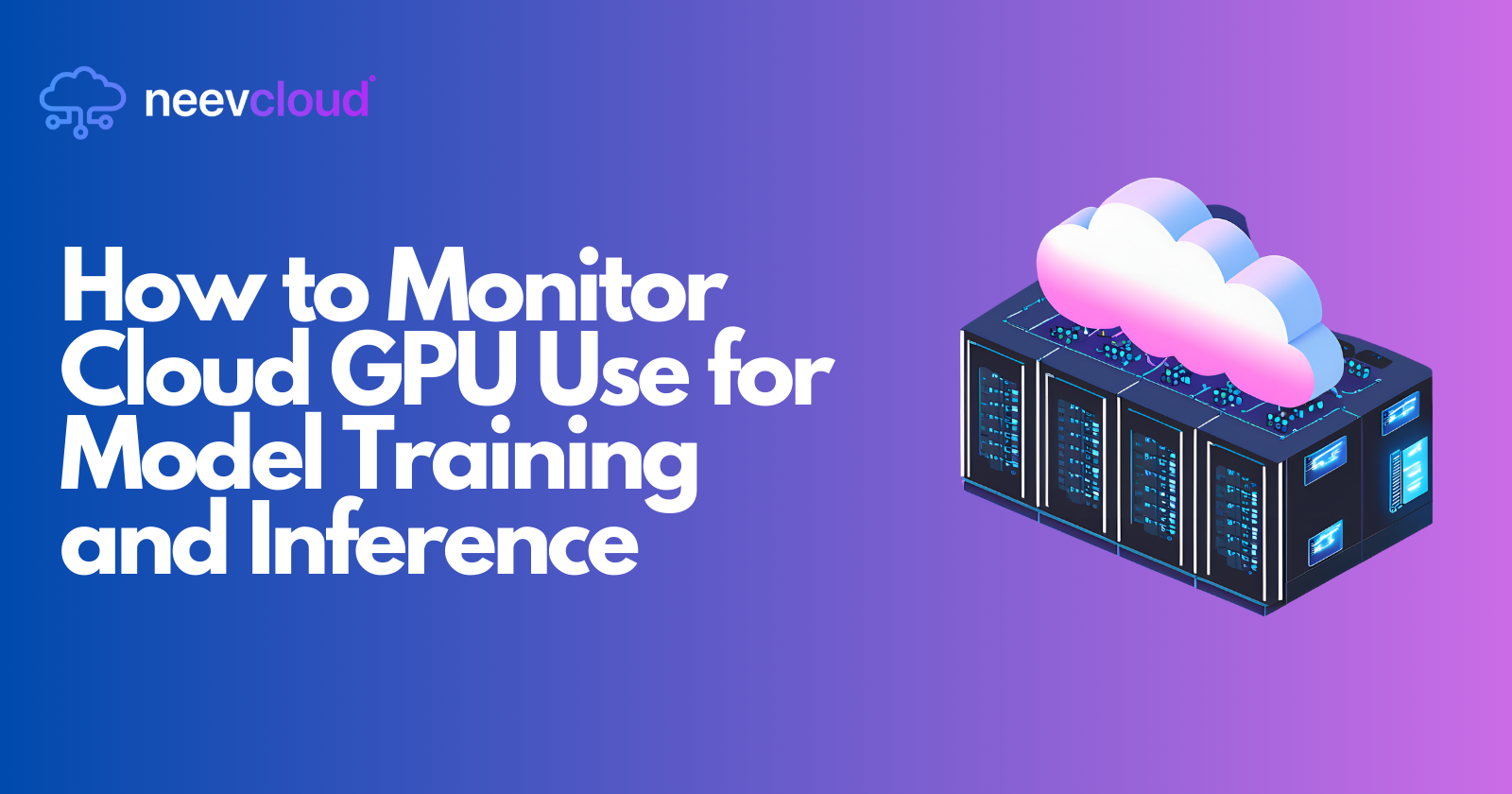How to Monitor Cloud GPU Use for Model Training and Inference
 Tanvi Ausare
Tanvi Ausare
In the evolving landscape of artificial intelligence (AI) and machine learning (ML), efficient resource utilization is critical. For AI Cloud environments and Cloud-based GPUs, monitoring utilization during model training and inference ensures cost-effectiveness, performance optimization, and resource planning. This article explores the significance of monitoring Cloud GPU usage, essential tools, techniques, and best practices for leveraging AI Datacenters.
Why Monitor GPU Utilisation in AI Cloud?
Cloud GPUs play a pivotal role in accelerating AI workloads, including training and inference. However, suboptimal utilization can lead to wasted resources or performance bottlenecks. Here’s why monitoring matters:
Performance Optimization: Identifies bottlenecks in data pipelines and improves overall throughput.
Cost Efficiency: Ensures GPU resources align with workload requirements, preventing over-provisioning.
Scalability: Provides insights into scaling infrastructure based on workload trends.
Model Accuracy: Detects underutilization, often caused by inefficient hyperparameters or data imbalance, impacting model training outcomes.
Predictive Maintenance: Identifies potential hardware or software failures to minimize downtime.
Key Metrics to Track GPU Utilisation
Monitoring Cloud-based GPUs requires attention to specific metrics, especially during AI model training and inference. These include:
GPU Utilization Percentage: Indicates the percentage of GPU capacity currently in use.
Memory Utilization: Tracks memory consumption to prevent out-of-memory errors during training or inference.
Compute Engine Utilization: Highlights usage patterns of CUDA cores, tensor cores, or ray-tracing cores.
Temperature and Power Usage: Helps maintain hardware health by preventing overheating or excessive power consumption.
Latency: Measures the delay between input data processing and output generation during inference.
Throughput: Quantifies the number of processed data samples per second.
Queue Occupancy: Identifies inefficiencies when jobs wait for execution due to resource constraints.
Tools for Monitoring Cloud GPU Utilisation
Several tools enable real-time and historical monitoring of Cloud GPU usage. Leveraging these ensures a comprehensive view of system performance:
NVIDIA DCGM (Data Center GPU Manager):
Provides real-time monitoring of GPU health, utilization, and performance.
Offers integration with AI Datacenter management platforms.
NVIDIA System Management Interface (nvidia-smi):
A command-line tool that tracks metrics like memory, temperature, and utilization.
Essential for debugging and on-the-fly performance analysis.
Prometheus & Grafana:
Prometheus collects GPU metrics, and Grafana visualizes them in custom dashboards.
Useful for long-term trend analysis in AI Cloud setups.
Cloud Provider Native Tools:
AWS CloudWatch, Google Cloud Operations, or Azure Monitor offer GPU tracking as part of their AI Cloud solutions.
Enables integration with broader cloud resource monitoring.
Custom Monitoring Scripts:
- Developers can build tailored scripts using libraries like PyCUDA or TensorFlow Profiler for workload-specific insights.
Best Practices for Monitoring Cloud-based GPUs
To make the most of your Cloud GPUs during model training and inference, follow these practices:
Establish Baselines: Determine normal utilization ranges for your workloads. Compare current metrics to identify anomalies.
Automate Alerts: Configure thresholds for critical metrics. Automate alerts to address performance dips or over-utilization immediately.
Visualize Trends: Use dashboards to correlate GPU utilization with other system metrics, such as CPU load or memory bandwidth.
Integrate AI Workflows: Embed monitoring into CI/CD pipelines for continuous visibility during AI model training updates.
Optimize Workloads: Regularly profile models to minimize unnecessary GPU resource consumption, especially for inference tasks.
Embrace Multi-GPU Scaling: Monitor inter-GPU communication to identify bottlenecks in distributed training scenarios.
Monitoring AI Model Training Workloads
Model training is resource-intensive, often requiring extensive GPU cycles. Monitoring ensures high efficiency, particularly for deep learning tasks:
Hyperparameter Tuning: Track GPU memory and compute usage to evaluate the efficiency of different configurations.
Batch Size Optimization: Monitor throughput to adjust batch sizes for maximizing GPU utilization without exceeding memory limits.
Data Pipeline Analysis: Evaluate I/O wait times to ensure data feeding pipelines do not underutilize GPUs.
Gradient Updates: Check synchronization latency during gradient updates in multi-GPU setups.
Long-running Tasks: Use monitoring to predict when long-running training tasks might face failures or stagnation.
Monitoring Inference Workloads
Inference often demands low latency and high throughput, making GPU monitoring critical:
Latency Monitoring: Pinpoint bottlenecks in data processing pipelines affecting response times.
Batch Inference Optimization: Analyze GPU utilization across different batch sizes to find an optimal trade-off between latency and throughput.
Dynamic Scaling: Monitor utilization trends to scale AI Datacenter resources during peak inference loads.
Model Optimization: Use metrics to identify underperforming model versions, triggering optimization efforts like pruning or quantization.
Challenges in GPU Monitoring and Solutions
Challenge: Lack of Visibility in Multi-cloud Environments
- Solution: Use centralized monitoring platforms that aggregate metrics across clouds.
Challenge: High Data Volume from GPU Metrics
- Solution: Implement sampling techniques or focus on critical metrics.
Challenge: Real-time Monitoring Overhead
- Solution: Leverage lightweight agents or asynchronous monitoring techniques.
Challenge: Inefficient Tool Integration
- Solution: Use APIs and SDKs from GPU vendors to standardize monitoring setups.
The Role of AI Datacenters in GPU Monitoring
AI Datacenters equipped with monitoring solutions streamline GPU resource management, offering features like:
Predictive Analytics: Detects patterns for resource planning.
Energy Efficiency Metrics: Tracks power usage for green computing initiatives.
Workload Optimization Suggestions: Recommends configurations for optimal GPU performance.
Future of GPU Monitoring in AI Cloud
The rapid evolution of AI workloads necessitates advancements in monitoring capabilities:
AI-driven Monitoring: Leverage AI models to predict and adapt GPU resource needs dynamically.
Edge GPU Monitoring: Enable robust monitoring for edge devices connected to Cloud-based GPUs.
Cross-layer Insights: Integrate GPU metrics with application performance data for holistic monitoring.
Security Integration: Monitor GPU usage anomalies to detect potential cybersecurity threats.
Conclusion
Monitoring Cloud GPU utilization is a cornerstone for achieving efficient AI model training and inference. With the right tools, practices, and insights, organizations can unlock the full potential of their AI Cloud investments. By focusing on metrics, integrating monitoring into workflows, and leveraging AI Datacenters, businesses can ensure optimized performance and sustained innovation in AI development.
Key Takeaways:
Monitoring GPU utilization prevents inefficiencies and resource wastage.
Use tools like NVIDIA DCGM, Prometheus, and Grafana for effective tracking.
Follow best practices like baseline establishment, automated alerts, and trend visualization.
Focus on specific monitoring strategies for model training and inference workloads.
Implementing robust GPU monitoring solutions can help your enterprise stay ahead in the competitive AI landscape, ensuring that your AI Cloud and Cloud-based GPU resources consistently deliver exceptional performance.
Subscribe to my newsletter
Read articles from Tanvi Ausare directly inside your inbox. Subscribe to the newsletter, and don't miss out.
Written by
